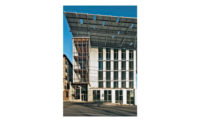Chiba, Japan
Even though Jin’s Global Standard occupies a busy corner inside a shopping center near Tokyo, this eyeglass boutique looks nothing like your typical suburban mall shop. Without flashy signage, conventional display tables, or even open floor area, the store is a visual curiosity, distinguished by a series of 3-foot-wide, 11-foot-high corridors. Formed by freestanding parallel walls that slice across the interior at a 45 degree angle, these deep passages invite customers to slip in for a peek or simply take a shortcut through the shop. “Normally, you don’t feel you can go in if you’re not going to buy,” explains its architect, Ryuji Nakamura. But here, the absence of doors—and the enticement of 1,500 pairs of glasses to try on—welcomes everyone.
The 1,076-square-foot store is the latest addition to Jin’s Global chain, headed by a visionary Japanese businessman. Though he’d started out in bags and belts, his discovery of how inexpensively glasses could be fabricated in China gave him the idea of turning prescription eyewear into must-have accessories. The frames, designed by his staff in Japan and then manufactured in China, are fit with made-to-order lenses at each of his 20-plus boutiques for less than $90 a pop (total)—and in under 30 minutes.
Here, production takes place in a narrow, L-shaped zone along the square space’s two inner faces. Cleverly and compactly sequestered behind walls, one leg contains waiting and eye-exam areas, and the other lens-molding and service counters, where customers place and pay for their orders. The corridors stand evenly spaced between a triangular pillar at the cash register and an encased structural column bearing subtle signage at the shop’s outermost corner. When the shop closes for the night, the employees simply pull down a cloth net (all the security needed here), instead of metal grilles or sliding-glass doors.
The boutique’s well-ordered geometry yields some unexpected visual experiences and twists of perception. While it is impossible to lose sight of the mall through the corridors, these discrete, floor-to-ceiling, canyonlike slots (each outfitted with its own sprinklers and halogen light fixtures) are simultaneously open-ended and narrowly enclosing. Nakamura relieves that tension with a pair of perpendicular circulation routes that cut through the walls with 2-foot-wide doorways. When viewed in perfect alignment, the openings appear to nest one inside the next, receding into space with amplified depth, reminiscent of a stage set—as striking from across the mall as from up close. Though this tunneling looks as if it could go on forever, it gently leads toward the cash register. Wall-mounted, rectangular mirrors compound the effect.
Want the full story? Read the entire article in our September 2007 issue.
PeopleOwner: Architect: Principal Architect: Ryuji Nakamura Architect in charge: Ryuji Nakamura Consultants: General contractor: AIM CREATE Co.,Ltd. Photographers: CAD system, project management, or other software used: AutoCAD |
ProductsExterior Cladding: Molding: SUNMENTO, Mihasi Co.,Ltd. Lighting : Conveyance:
|











Post a comment to this article
Report Abusive Comment